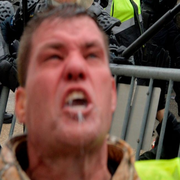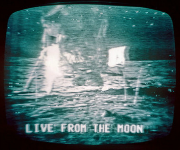|
On the one hand, you could probably build an auto-levelling computer that will keep the ship balanced. On the other hand I would be absolutely terrified of that conputer.
|
|
|
|

|
| # ? Apr 29, 2024 00:06 |
|
Jobbo_Fett posted:Not directly, but the plan was to control the mediterranean and force the Allies to go around the Horn of Africa. This was accomplished like as soon as the Luftwaffe started using Italian airbases. The Central Mediterranean became too dangerous for all but the most heavily escorted convoys. The route around Africa delayed things, but ultimately the Allies had enough ships that the incoming supply was more than sufficient.
|
|
|
|
Why was it necessary to besiege Petersburg to expose Richmond instead of just besieging Richmond?
|
|
|
|
As I understand the reasoning, Petersburg was the main rail-head that supplied Richmond. Grant tried a few times to get between Petersburg and Richmond (and thus isolate the city from its main railhead, and thus logistical base), but due to a combination of alert Confederate planning and incompetent Union generalship, he was eventually forced to try to countermarch Lee's southern flank until eventually the siege lines extend from Richmond all the way to Petersburg and beyond. It's not so much that Petersburg was the intention from the start, it's more that that's how it evolved. If anything, Grant tried to prevent the siege of Petersburg from happening at all, but ultimately it's what the strategic realities on the ground made possible. Had Grant been able to get between Petersburg and Richmond, the war very likely would've end some months earlier than it did, but this counterfactual ignores that what ultimately ended the war for good was the absolute exhaustion that the siege of Petersburg brought on. The Confederate war machine was already very creaky and decrepit by the summer of 1864, and the last effort it gave for the defense of Richmond was ultimately the nail in the coffin.
|
|
|
|
TooMuchAbstraction posted:Keep the water on the outside. Keep the fire away from fuel and explosives. Those are the big issues as I understand it. Ships don't move anywhere if you don't let some fire meet with fuel. Occasionally you will also want to 'fire' your explosives, but in a controlled manner.
|
|
|
|
Nenonen posted:Ships don't move anywhere if you don't let some fire meet with fuel. Occasionally you will also want to 'fire' your explosives, but in a controlled manner. Balderdash. The Royal Navy is doing tall ship training again.
|
|
|
|
Lawman 0 posted:Did the italians have a plan to try and block the Suez canal in ww2? The Germans used aircraft, flying from Rhodes and Crete, to lay mines in the canal in 1941—2. This never fully blocked the canal, but did result in major delays for ships carrying supplies and reinforcements to 8th Army in Egypt. Some of the ships in these traffic jams would be hit by German aircraft too. The Thistlegorm, a famous dive site in the Red Sea, was one of these ships.
|
|
|
|
Nenonen posted:Ships don't move anywhere if you don't let some fire meet with fuel. Occasionally you will also want to 'fire' your explosives, but in a controlled manner. Apart from the thousands of goddamned years when everyone used oars or sails exclusively, you mean.
|
|
|
|
Hey now, don't forget ropes or paddle wheels.
|
|
|
|
Vincent Van Goatse posted:Apart from the thousands of goddamned years when everyone used oars or sails exclusively, you mean. Where is the fuel for sails and oars stored? Better keep the fire out of there!
|
|
|
|
Nobody likes burning seamen.
|
|
|
|
|
SeanBeansShako posted:Nobody likes burning seamen.
|
|
|
|
The Byzantines did!
|
|
|
|
SeanBeansShako posted:Nobody likes burning seamen. The smell is just awful.
|
|
|
|
Whoops, seems I missed two weeks worth of updates: Allies view of the Maus Winter and swamp tracks Queue: Winter and swamp tracks, Paper light tank destroyers, Allied intel on the Maus , Summary of French interbellum tank development, Medium Tank T20, Medium Tank T23, Myths of Soviet tank building, GMC M10, Tiger II predecessors, Pz.Kpfw.IV Ausf.H-J,IS-6, SU-101/SU-102/Uralmash-1, Centurion Mk.I, SU-100 front line impressions, IS-2 front line impressions, Myths of Soviet tank building: early Great Patriotic War, Influence of the T-34 on German tank building, Medium Tank T25, Heavy Tank T26/T26E1/T26E3, Career of Harry Knox, GMC M36, Geschützwagen Tiger für 17cm K72 (Sf), Early Early Soviet tank development (MS-1, AN Teplokhod), Career of Semyon Aleksandrovich Ginzburg, AT-1, Object 140, SU-76 frontline impressions, Creation of the IS-3, IS-6, SU-5, Myths of Soviet tank building: 1943-44, IS-2 post-war modifications, Myths of Soviet tank building: end of the Great Patriotic War, Medium Tank T6, RPG-1, Lahti L-39, American tank building plans post-war, German tanks for 1946, HMC M7 Priest, GMC M12, GMC M40/M43, ISU-152, AMR 35 ZT, Soviet post-war tank building plans, T-100Y and SU-14-1, Object 430, Pz.Kpfw.35(t), T-60 tanks in combat, SU-76M modernizations, Panhard 178, 15 cm sFH 13/1 (Sf), 43M ZrŪnyi, Medium Tank M46, Modernization of the M48 to the M60 standard, German tank building trends at the end of WW2, Pz.Kpfw.III/IV, E-50 and E-75 development, Pre-war and early war British tank building, BT-7M/A-8 trials, Jagdtiger suspension, Light Tank T37, Light Tank T41, T-26-6 (SU-26), Voroshilovets tractor trials. Available for request (others' articles):  Shashmurin's career T-55 underwater driving equipment T-64's composite armour Oerlikon and Solothurn anti-tank rifles Evolution of German tank observation devices Ensign Expendable fucked around with this message at 14:13 on Mar 29, 2021 |
|
|
|
I know this isnít quite the right thread, but I was curious how militaries keep up to date on plans for how to fight large scale traditional wars when it has been awhile since the last one. Especially curious about what they do when itís been awhile since the last fight between major powers/there has been some big technological changes. Is it just a ton of theorizing and observing whatever conflicts they can? Have been wondering about this recently since it seems like it would be quite hard in the present day to get a great sense of what conflict between major powers would look like.
|
|
|
|
Wasnít desert storm such a bloodbath because our systems worked way better than any of the planners had expected? Iíd assume every development made since the last peer war is just a crapshoot on if itís actually going to work or not. Didnít the russian anti air system get clowned on recently?
|
|
|
|
|
TK-42-1 posted:Wasnít desert storm such a bloodbath because our systems worked way better than any of the planners had expected? Iíd assume every development made since the last peer war is just a crapshoot on if itís actually going to work or not. Didnít the russian anti air system get clowned on recently? A little bit, but a large part of it was the assumption that after a ten year war with Iran, the Iraqi army was battle hardened and had substantial experience of conventional warfare (that the US army did not!). It turned out that that experience wasn't really worth anything.
|
|
|
|
Also, ten years of battle damage and fatigue mattered.
|
|
|
|
Experience is not gonna matter much if you are sat in a tank without night vision and GPS expecting your enemy to come up the road to attack your prepared position and instead they just cut through the desert into your flank en masse and shoot you at night during a sandstorm with excellent accuracy- and you can't even see them other than some subdued muzzle flashes in the murk Parts of battles like 73 easting turned out like a video game with cheats enabled
|
|
|
|
Ensign Expendable posted:Whoops, seems I missed two weeks worth of updates: BT-7M/A-8 trials, Jagdtiger suspension, Light Tank T37, Light Tank T41, T-26-6 (SU-26), Voroshilovets tractor trials.
|
|
|
|
IIRC Iraq was using a lot of obsolete Soviet surplus, meaning that the American gear was fighting precisely the enemies that they had been designed to counter.
|
|
|
|
The other thing about Gulf War 1 is that because of the fact that the coalition was very worried about the capability of the Iraqi army, the buildup was taken very seriously and a seriously huge amount of force was thrown at Iraq in what turned out to be overkill. Compare the 2003 invasion when the military have their assessment of how much money and troops it would take to occupy the country, and Rumsfeld told them they were being too pessimistic (in part based on how much of a pushover Iraq turned out to be the first time round) and cut the troop allowance drastically with catastrophic results (assuming you think that a good outcome was ever possible).
|
|
|
|
tildes posted:I know this isnít quite the right thread, but I was curious how militaries keep up to date on plans for how to fight large scale traditional wars when it has been awhile since the last one. Especially curious about what they do when itís been awhile since the last fight between major powers/there has been some big technological changes. Is it just a ton of theorizing and observing whatever conflicts they can? Have been wondering about this recently since it seems like it would be quite hard in the present day to get a great sense of what conflict between major powers would look like. Also large-scale exercises and war gaming (in the traditional sense, i.e. tabletop exercises etc.) That said historically a lot of it ends up being wrong.
|
|
|
|
The talk of tanks doing anything on top of snow is 99% bullshit. I'm sure the wider tracks helped with traction going uphill in some limited situations but the idea of the T34 going over some massive snowbank that is deeper than the T34 is tall is just not happening. Even snowcats, which have a ground pressure of about 1-1.5psi (70g-105.4g/cm2) are too heavy and sink through the light fluffy snowfalls if they are too deep. This is roughly 3x less ground pressure than the T34 supposedly has with snow tracks on. (270g/cm2)
|
|
|
|
|
My understanding is that it's less that these tanks didn't sink in snow, and more that they sunk sufficiently little and had enough traction/sufficiently powerful engines that they were able to bulldoze themselves through anyway.
|
|
|
|
MikeCrotch posted:Compare the 2003 invasion when the military have their assessment of how much money and troops it would take to occupy the country, and Rumsfeld told them they were being too pessimistic (in part based on how much of a pushover Iraq turned out to be the first time round) and cut the troop allowance drastically with catastrophic results (assuming you think that a good outcome was ever possible). I mean, the military very carefully didn't occupy Iraq the first time round, it just defeated the Iraqi army and went home. It did that just fine the second time around too, but 'how many people do you need to occupy and rebuild a country of 40 million people over an extended period of time' wasn't a question that the first war could have given you an answer to, and Rumsfeld obviously got it extremely wrong.
|
|
|
|
MikeCrotch posted:The other thing about Gulf War 1 is that because of the fact that the coalition was very worried about the capability of the Iraqi army, the buildup was taken very seriously and a seriously huge amount of force was thrown at Iraq in what turned out to be overkill. The OOBs from GW1 are shockingly huge. That level of force projection became impossible shortly thereafter.
|
|
|
|
The other thing to consider about the 1991 Gulf War is that it took place right before the Cold War drawdowns and demobilizations. In fact I think Saddam was banking on the Soviets to act as some sort of mediator not realizing that they were instead busy imploding?
|
|
|
|
French interbellum tank building Queue: Medium Tank T20, Medium Tank T23, Myths of Soviet tank building, GMC M10, Tiger II predecessors, Pz.Kpfw.IV Ausf.H-J,IS-6, SU-101/SU-102/Uralmash-1, Centurion Mk.I, SU-100 front line impressions, IS-2 front line impressions, Myths of Soviet tank building: early Great Patriotic War, Influence of the T-34 on German tank building, Medium Tank T25, Heavy Tank T26/T26E1/T26E3, Career of Harry Knox, GMC M36, Geschützwagen Tiger für 17cm K72 (Sf), Early Early Soviet tank development (MS-1, AN Teplokhod), Career of Semyon Aleksandrovich Ginzburg, AT-1, Object 140, SU-76 frontline impressions, Creation of the IS-3, IS-6, SU-5, Myths of Soviet tank building: 1943-44, IS-2 post-war modifications, Myths of Soviet tank building: end of the Great Patriotic War, Medium Tank T6, RPG-1, Lahti L-39, American tank building plans post-war, German tanks for 1946, HMC M7 Priest, GMC M12, GMC M40/M43, ISU-152, AMR 35 ZT, Soviet post-war tank building plans, T-100Y and SU-14-1, Object 430, Pz.Kpfw.35(t), T-60 tanks in combat, SU-76M modernizations, Panhard 178, 15 cm sFH 13/1 (Sf), 43M ZrŪnyi, Medium Tank M46, Modernization of the M48 to the M60 standard, German tank building trends at the end of WW2, Pz.Kpfw.III/IV, E-50 and E-75 development, Pre-war and early war British tank building, BT-7M/A-8 trials, Jagdtiger suspension, Light Tank T37, Light Tank T41, T-26-6 (SU-26), Voroshilovets tractor trials. Available for request (others' articles):  Shashmurin's career T-55 underwater driving equipment T-64's composite armour Oerlikon and Solothurn anti-tank rifles Evolution of German tank observation devices
|
|
|
|
tildes posted:I know this isnít quite the right thread, but I was curious how militaries keep up to date on plans for how to fight large scale traditional wars when it has been awhile since the last one. Especially curious about what they do when itís been awhile since the last fight between major powers/there has been some big technological changes. Is it just a ton of theorizing and observing whatever conflicts they can? Have been wondering about this recently since it seems like it would be quite hard in the present day to get a great sense of what conflict between major powers would look like. The US spends a TON of time and money and man hours pondering this stuff. It starts with "concepts," which is where I worked for several years! Concepts focuses on the period "outside the POM (program objective memorandum, basically how the DoD is going to spend money over a 5 year period, broken down into rolling cycles) which means 8 to roughly 30 years out. Futures Command does all kinds of wargames and experiments and seminars and so on (collectively called "the Campaign of Learning") to try and validate their stuff; the main output is a big set of "required capabilities" that they decide are most important for the future. Those required capabilities are then measured against current capabilities, gaps are identified and then rank-ordered by priority. These gaps are what combat developers, force developers and eventually the defense industry uses to define the scope of their work. Short-range air defense is a great example that I was neck-deep in for quite some time. Even before the drone craze of about 10 years ago, as the army's focus began to switch from GWOT to major combat ops again, experimentation showed very clearly that the future force was hideously vulnerable to attack and surveillance from all manner of tactical air platforms. This was codified as a gap, and off it went for consideration. Between the absurd ongoing costs of GWOT operations and the lack of an identified threat, the SHORAD gap was sort of buried down the prioritized gap list...until the drone craze happened, and all of a sudden, everyone suddenly wondered where the hell the air defense was. It was subsequently vaulted up to the very top of the list. The good news was that thanks to the previous years' experiments, we'd already produced several of the concepts of operations that would form the basis for future systems like IFPC and M-SHORAD. These are now well along in the development process. Everyone involved in the futures world realizes that they could absolutely get everything terribly wrong, but I still think the process has a lot of value. The incredibly long gestation time of modern systems and the amount of time it takes to grow modern soldiers/leaders makes this stuff very important. It isn't likely that a future army can be grown from scratch in a matter of months as were the ones that fought the world wars; getting the future force as close to right as possible counts for a lot. bewbies fucked around with this message at 14:18 on Mar 29, 2021 |
|
|
|
bewbies posted:IFPC and M-SHORAD Googled M-SHORAD, found an article with this helpful image+caption combo: 
|
|
|
|
DesperateDan posted:Experience is not gonna matter much if you are sat in a tank without night vision and GPS expecting your enemy to come up the road to attack your prepared position and instead they just cut through the desert into your flank en masse and shoot you at night during a sandstorm with excellent accuracy- and you can't even see them other than some subdued muzzle flashes in the murk What was the state of Iraqi night-fighting equipment, anyway? It seems odd that they'd neglect such a key technology and obvious advantage. Did the Soviets just not like to export it, or something?
|
|
|
|
Gort posted:What was the state of Iraqi night-fighting equipment, anyway? For the most part, sitting in a tank burned by TOW missiles, rendering it irrelevant.
|
|
|
|
Gort posted:What was the state of Iraqi night-fighting equipment, anyway? It seems odd that they'd neglect such a key technology and obvious advantage. Did the Soviets just not like to export it, or something? There is a big difference between night vision and thermals
|
|
|
|
Gort posted:What was the state of Iraqi night-fighting equipment, anyway? It seems odd that they'd neglect such a key technology and obvious advantage. Did the Soviets just not like to export it, or something? i think you're forgetting the era this happened in. it's easy to take for granted what is available today, but back at the tail end of the cold war modern NVG and thermal imaging systems were cutting edge and extremely expensive, for both the USSR and the US, and the soviets not only had a big capability gap with the US at this point but didn't export their top-of-the-line systems and sensors.
|
|
|
|
Gort posted:What was the state of Iraqi night-fighting equipment, anyway? It seems odd that they'd neglect such a key technology and obvious advantage. Did the Soviets just not like to export it, or something? IIRC export T-72s had image intensifiers and infrared searchlights but the thermal sights the US tanks were equipped with were an entirely different league. It's also worth mentioning the Soviets were real behind when it came to night fighting equipment. One of the reasons they didn't export any thermal sights was they didn't really have any in service themselves. I think the T-80U was the first tank to get them, and only as an upgrade of which they didn't add in any appreciable numbers until after the Soviet Union collapsed.
|
|
|
|
Gort posted:What was the state of Iraqi night-fighting equipment, anyway? It seems odd that they'd neglect such a key technology and obvious advantage. Did the Soviets just not like to export it, or something? 1st generation night vision sights depended on a powerful infrared lamp that illuminated everything. The sight would then catch the IR light waves and convert them to visible light. The problem with such active illumination is obvious: if they have any kind of infrared sights, then it's the same if you were waving a flashlight in darkness.
|
|
|
|
brains posted:i think you're forgetting the era this happened in. it's easy to take for granted what is available today, but back at the tail end of the cold war modern NVG and thermal imaging systems were cutting edge and extremely expensive, for both the USSR and the US, and the soviets not only had a big capability gap with the US at this point but didn't export their top-of-the-line systems and sensors. No, that's not correct, sorry. Night vision devices were introduced at the tail end of WWII and used in Korea. They were used regularly in Vietnam (the "Starlite scope"). They were widely available in the Gulf. Every US armored vehicle in the Gulf had at least one and probably more than two night vision devices available. Drivers on old M-60A1s had the ANVVS, gunners and TCs had M36E1s with night vision, and almost every tank had at least one set of NVGs for the TC. USMC AAVs had a similar system, ANVVS for the driver, M36E1s for the crew chief, and a set of NVGs on board. The Iraqis had TKN-1s at a minimum on their old T-55 clones and BMPs. They weren't great, but they did have them.
|
|
|
|

|
| # ? Apr 29, 2024 00:06 |
|
Cessna posted:No, that's not correct, sorry. i'm not trying to say NVG and thermal imaging were invented in 1991, but there was a huge qualitative difference between the imaging systems on export T-55s and the imaging sensors on an Abrams, and the Iraq armed forces (or any Soviet-equipped military of the time) definitely did not have the quantitative numbers of imaging systems fielded anywhere near what the US military had. nobody did, it wasn't even close. and the sensors being fielded in the US in the late 80s/90s were most certainly cutting edge and cost a fortune, but the Regan-era US military was spending cash at incredible rates. you could argue that the US military's prowess at night fighting during the first Gulf War was even more revolutionary than the use of precision-guided weapons, which were actually quite limited in numbers during that campaign.
|
|
|











































